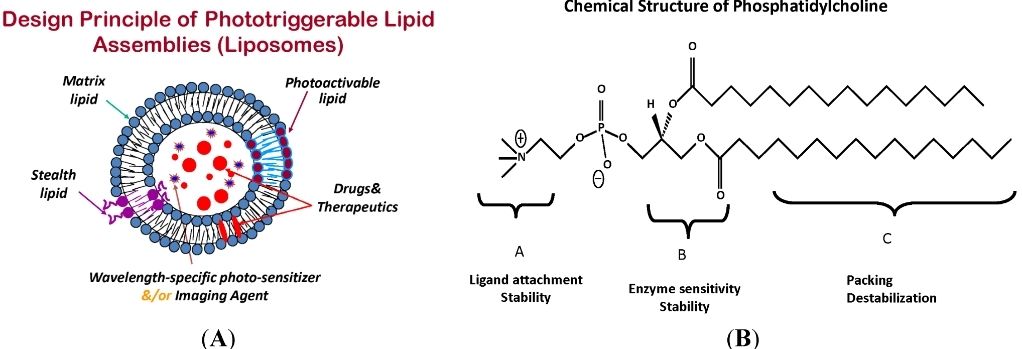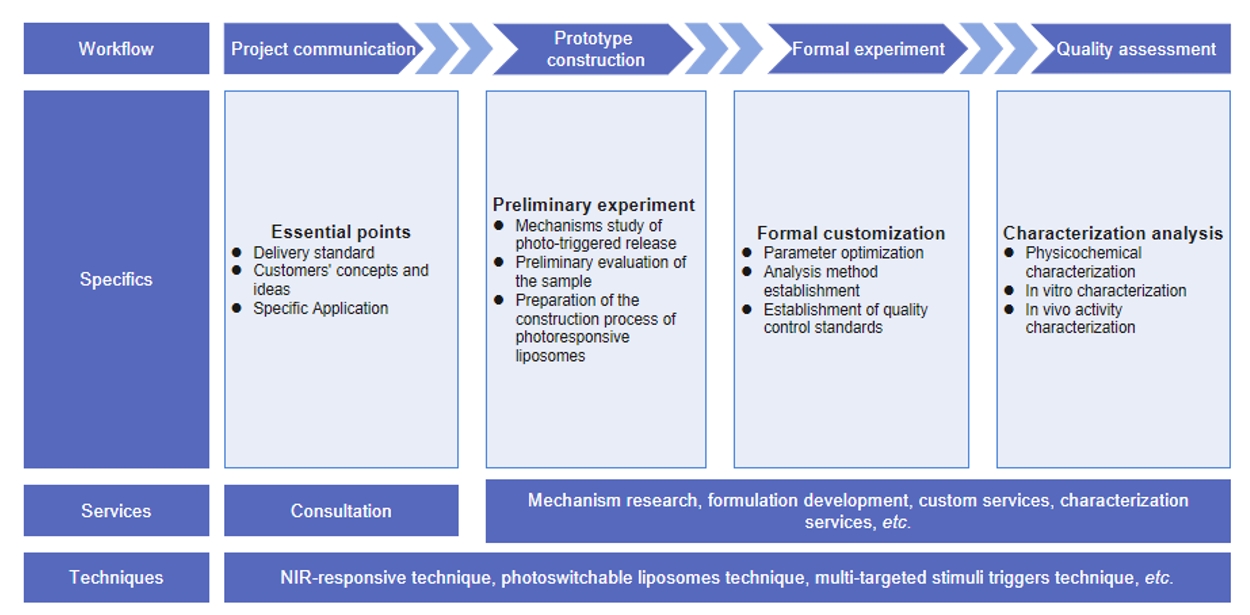Custom Light-responsive Liposome Service
Inquiry
Light-responsive liposomes are celebrated as one of the most advanced targeted delivery systems, offering non-invasive administration, high spatial resolution, precise time control, broad wavelength tunability, and exceptional robustness. As a leading global company specializing in nanoparticle formulation, CD Formulation leverages cutting-edge technology and extensive expertise to develop and customize liposomes. Our commitment is to propel research and innovation in the field with bespoke light-responsive liposome formulations.
What are Light-responsive Liposomes?
Phototriggered liposome systems usually contain a photosensitive group that is chemically engineered into the selected lipid. The goal of using trigger-able lipids is to introduce defects in the liposome membrane for local drug delivery. The potential modifiable sites within phospholipids can be divided into three regions, namely, the head group, the glycerol skeleton, and the fatty acyl chain. Light-triggered mechanisms for the release of encapsulated drugs from liposomes generally include photoisomerization, photolysis (photo-oxidation), surface plasmon resonance absorption (photothermal activation), photochemical hydrophobicity change (photochemical activation), and photo-crosslinking and de-crosslinking.
 Fig.1 Schematic diagram of phototriggerable/light-responsive liposome assembly. (Agiba AM, et al., 2024)
Fig.1 Schematic diagram of phototriggerable/light-responsive liposome assembly. (Agiba AM, et al., 2024)
Our Light-responsive Liposome Customization Service
Mechanisms study of photo-triggered release
We assist clients in comprehending and developing various intelligent light-responsive liposome systems by investigating these mechanisms, including photoisomerization, photolysis (photooxidation), surface plasmon resonance absorption (photothermal activation), photochemical hydrophobic alteration (photochemical activation), photo-crosslinking and de-crosslinking.
Light-responsive Liposome customization
a. Near-infrared (NIR)-responsive liposomes
The penetration depth of the selected light source is related to the mechanism of drug release triggered by light. The current preferred wavelength for therapeutic and biomedical applications is the near-infrared region (~700-1100 nm), which is superior to ultraviolet and visible light because of the penetration depth of more than 1cm. We possess the capacity to tailor-design an extensive array of NIR-liposome formulations, including near-infrared activated thermosensitive liposomes, to facilitate protein delivery.
b. Liposomes containing porphyrin derivatives
To formulate successful photo-triggerable porphyrincontaining liposomes, we generally consider several criteria, particularly regarding photosensitizers (structural and photophysical properties) and phospholipids (phototriggering mechanism, such as unsaturated or polyunsaturated phospholipids, the more olefin double bonds in the alkyl chain, the higher the light-triggered release efficiency).
c. Multi-targeted stimuli-triggers liposomes
Compared to traditional liposomes, muti-targeted liposomes offer several advantages, including the ability to target two or more receptors, enhanced internalization into tumor cells, improved efficiency and precision in drug release, in addition to reduced toxicity to normal tissues. By integrating two distinct stimuli within a single liposomal formulation, precise site-specificity, and multilevel targeting can be achieved. We can supply muti-targeted liposomes, such as light /pH responsive liposomes and temperature/light responsive liposomes.
d. photoswitchable liposomes
This service assists in studying photoswitchable liposomes such as amphiphilic liposome photoswitchable fluorescent probes, azobenzene photoswitch in liposomes, photoinduced liposome–fiber assembly-transition, etc.
Study on phototargeted drug delivery strategy
We can offer a range of light-targeted drug delivery strategies, including three main approaches: targeted phototargeting through the activation of targeting ligands, targeted phototargeting by reducing particle size, and targeted phototargeting through blood vessel destruction.
 Fig.2 Schematic diagram of our workflow. (CD Formulation)
Fig.2 Schematic diagram of our workflow. (CD Formulation)
Our Platforms for Light-responsive Liposome Customization
We have established a proprietary platform for the development of pH-sensitive liposomes and can offer the following technologies:
| Techniques and Platforms |
Specifics |
| Light-sensitive Development Techniques |
- This platform supports various light-triggered liposomes (including photoswitchable liposomes, NIR-responsive liposomes, and multi-targeted stimuli-triggers liposomes.) and study phototargeted drug delivery strategy.
|
| In Vitro Characterization Platform |
- In vitro release evaluation.
- Light stimulation response assessment.
- Skin penetration study.
- Physical and chemical properties, including determination of particle size, zeta potential, and assessment of leakage rate.
|
| Mechanisms Study Platform of Light-sensitive Liposomes |
- Investigating mechanisms: including photooxidation, photothermal activation, photochemical activation, and photo-crosslinking and de-crosslinking.
- To study photoswitchable liposomes including amphiphilic liposome photoswitchable fluorescent probe.
|
| Application Development Platform of Light-sensitive Liposomes |
- To explore the application possibilities of light-sensitive liposomes in various fields.
- Conventional application areas include anti-cancer therapy, anti-infection therapy, gene therapy, and special, such as indicator delivery systems, biosensors, etc.
|
Why Choose CD Formulation?
- Skilled teams. Our research team consists of a group of scientists who are proficient in immunology, medicine, biology, and other disciplines, and have extensive experience in developing biological delivery systems, particularly in the area of light-sensitive liposome delivery systems.
- Top-notch light-sensitive liposome development techniques. We employ a range of technologies for tailoring liposomes to meet the specific light sensitivity requirements of our clients including strategy photoswitchable liposome technique, NIR-responsive liposome technique, multi-targeted stimuli-triggers liposome technique.
- Customized diversification. Our light-sensitive liposome products are tailored to meet the research and application requirements of diverse industries, including but not limited to cancer research, anti-inflammatory research, contrast agent development, biosensors, cell research, biomedical applications, agriculture, and botany.
Published Data
Technology: Liposomes Responsive to Near-Infrared Light for Protein Delivery Techniques
Journal: Journal of Controlled Release
IF: 10.5
Published: 2021
Results: In this study, the authors designed a near-infrared (NIR) light-responsive liposome gold nanorod (AuNR) platform for on-demand protein delivery using a mixture of ultra-small AuNRs, thermosensitive phospholipids (DPPC), and non-ionic surfactant (Brij58). Results show that by combining light-triggered liposome uPA delivery/release with the gold nanorod's photothermal thrombolytic action, low-dose, site-specific thrombolysis can be achieved. The newly designed gold nanorod-based NIR light-responsive liposome represents a promising drug delivery system for site-directed, photo-thermal stimulated protein release.
 Fig.3 Mechanism of the near-infrared liposomes. (Ahmed Refaat, et al., 2021)
Fig.3 Mechanism of the near-infrared liposomes. (Ahmed Refaat, et al., 2021)
CD Formulation has established a specialized platform for light-sensitive liposomes to offer customers a wide range of highly effective light-sensitive liposome products. Please do not hesitate to contact us if you require any assistance.
References
-
Agiba AM, Arreola-Ramírez JL, et al. Light-Responsive and Dual-Targeting Liposomes: From Mechanisms to Targeting Strategies. Molecules. 2024; 29(3):636.
- Ahmed Refaat, Blanca del Rosal, et al. Near-infrared light-responsive liposomes for protein delivery: Towards bleeding-free photothermally-assisted thrombolysis. Journal of Controlled Release, 2021, Volume 337, Pages 212-223.
How It Works
STEP 2
We'll email you to provide your quote and confirm order details if applicable.
STEP 3
Execute the project with real-time communication, and deliver the final report promptly.
Related Services


 Fig.1 Schematic diagram of phototriggerable/light-responsive liposome assembly. (Agiba AM, et al., 2024)
Fig.1 Schematic diagram of phototriggerable/light-responsive liposome assembly. (Agiba AM, et al., 2024) Fig.2 Schematic diagram of our workflow. (CD Formulation)
Fig.2 Schematic diagram of our workflow. (CD Formulation) Fig.3 Mechanism of the near-infrared liposomes. (Ahmed Refaat, et al., 2021)
Fig.3 Mechanism of the near-infrared liposomes. (Ahmed Refaat, et al., 2021)
